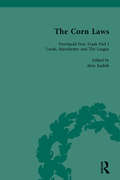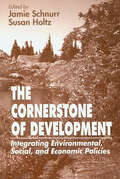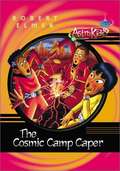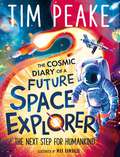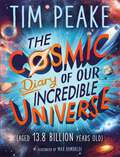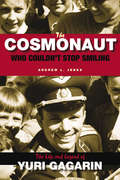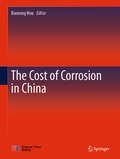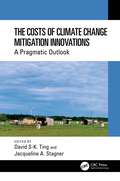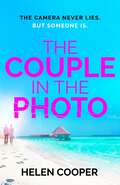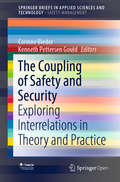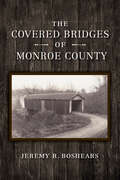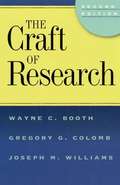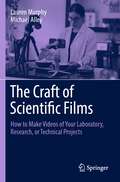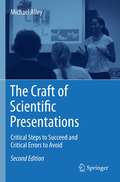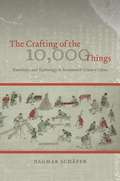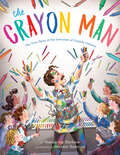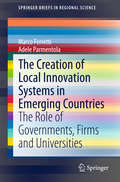- Table View
- List View
The Corn Laws Vol 5: The Formation Of Popular Economics In Britain
by Alon KadishThe pamphlets, newspaper articles and tracts in this collection provide source material for the study of the Anti-Corn Law campaigns of the 1830s and 1840s and their role in the formation of popular economics in Britain. Volume 5 covers entries from 1839 to 1842.
The Cornerstone of Development: Integrating Environmental, Social, and Economic Policies
by Jamie Schnurr 0 Idrc Susan Holtz Greg Armstrong Anne K Bernard"Sustainable development" quickly became the universal goal for environmentalists in the 1990s, motivated by the 1988 Brundtland Report and the 1992 Earth Summit in Rio. When the time came to bring theory into reality, sustainable development revealed far more complexity than first anticipated.To attain sustainable development in the full sense of the phrase"meeting present needs without compromising the resources needed for future societies"environmental and social concerns would need a constant presence in all major economic decisions.The Cornerstone of Development: Balancing Environmental, Social, and Economic Imperatives profiles many of the first attempts to implement sustainable development initiatives worldwide. The model: Canada's experience with "multistakeholder" decision-making. Under the guidance of Canada's National Task Force on Environment and Economy, nationwide and provincial round tables brought government officials together with corporate officers to formulate sustainable development guidelines.Authorized by the Canadian government to serve as an "Agenda 21 organization," the International Development Research Centre (IDRC) subsequently researched the feasibility of adapting the multistakeholder approach to the needs and practices of developing countries. The results are in these pages: valuable case histories from Africa, Latin America, Asia and Canada, each recounting the risks and benefits from integrating environmental, social and economic policies.When IDRC members were asked for ways to address environmental sustainability, they had few examples to follow"and little evidence that such endeavors could be fulfilled. The research and problem-solving efforts they produced are now collected here, for the guidance of other environment/development balance programs worldwide.
The Correspondence Of Charles Darwin: Volume 20 1872
by Janet Browne Frederick Burkhardt James A. Secord Samantha Evans Shelley Innes Francis Neary Alison M. Pearn Anne Secord Paul WhiteThis volume is part of the definitive edition of letters written by and to Charles Darwin, the most celebrated naturalist of the nineteenth century. Notes and appendixes put these fascinating and wide-ranging letters in context, making the letters accessible to both scholars and general readers. Darwin depended on correspondence to collect data from all over the world, and to discuss his emerging ideas with scientific colleagues, many of whom he never met in person. The letters are published chronologically: volume 20 includes letters from 1872, the year in which The expression of the emotions in man and animals was published, making ground-breaking use of photography. Also in this year, the sixth and final edition of On the origin of species was published, and Darwin resumed his work on carnivorous plants and plant movement, finding unexpected similarities between the plant and animal kingdoms.
The Correspondence of Charles Darwin
by Frederick Burkhardt James A. SecordOver 850 letters between Darwin and worldwide correspondents, as he gathered information on human origins and the expression of emotion.
The Correspondence of Charles Darwin 1877: VOLUME 25 (The Correspondence of Charles Darwin)
by Frederick Burkhardt James A. SecordThis volume is part of the definitive edition of letters written by and to Charles Darwin, the most celebrated naturalist of the nineteenth century. Notes and appendixes put these fascinating and wide-ranging letters in context, making the letters accessible to both scholars and general readers. Darwin depended on correspondence to collect data from all over the world, and to discuss his emerging ideas with scientific colleagues, many of whom he never met in person. The letters are published chronologically: volume 25 includes letters from 1877, the year in which Darwin published Forms of Flowers and with his son Francis carried out experiments on plant movement and bloom on plants. Darwin was awarded an honorary LL. D. by Cambridge University, and appeared in person to receive it. The volume contains a number of appendixes, including two on the albums of photograph sent to Darwin by his Dutch, German, and Austrian admirers.
The Correspondence of Charles Darwin: VOLUME 24
by Frederick Burkhardt James A. SecordThis volume is part of the definitive edition of letters written by and to Charles Darwin, the most celebrated naturalist of the nineteenth century. Notes and appendixes put these fascinating and wide-ranging letters in context, making the letters accessible to both scholars and general readers. Darwin depended on correspondence to collect data from all over the world, and to discuss his emerging ideas with scientific colleagues, many of whom he never met in person. The letters are published chronologically: volume 24 includes letters from 1876, the year in which Darwin published Cross and Self Fertilisation in the Vegetable Kingdom, and started writing Forms of Flowers. In 1876, Darwin's daughter-in-law, Amy, died shortly after giving birth to a son, Bernard Darwin, an event that devastated the family. The volume includes a supplement of 182 letters from earlier years, including a newly discovered collection of letters from William Darwin, Darwin's eldest son.
The Cosmic Camp Caper (AstroKids #6)
by Robert ElmerThe gang thought they would be roasting marshmallows over miniature volcanoes and practicing laser archery, but instead, Camp Little Dipper proves to be something else entirely. Book 6 of AstroKids.
The Cosmic Diary of a Future Space Explorer: The Next Step for Humankind (The Cosmic Diary of)
by Steve Cole Tim PeakeDear Diary, hello to Planet Earth! Today I'm far from home, floating around in the atmosphere, and wow the stars look magical from here... Do you want to know what it's like to be a REAL-LIFE astronaut? If you've ever wanted to blast off into space, you're about to find out everything you need to become an astronaut - and the answers to all the big questions like, how do you wee in space? What can you see from the International Space Station? And how could we build a colony on Mars?Your mission, if you choose to accept, is to pull on your spacesuit and join your guide, real astronaut Tim Peake (and a host of expert STEM characters) in this fascinating adventure through space, time and the diary of one truly incredible space adventure. Join us for some iconic space adventures, plus discover the voyages we might make in the future...Written by real-life astronaut Tim Peake, this children's non-fiction book is essential for readers who want to blast into space and discover more about the universe and our place in it.
The Cosmic Diary of a Future Space Explorer: The Next Step for Humankind (The Cosmic Diary of)
by Steve Cole Tim PeakeA real-life astronaut is here to tell you what it's REALLY like to blast off into space - and everywhere we might travel in the future! Could we build a colony on Mars? Will we ever land on Venus? Can we play football on the Moon?Your mission, if you choose to accept, is to pull on your spacesuit and join your guide, real astronaut Tim Peake (and a host of expert STEM characters), in this fascinating adventure through space, time and the diary of one truly incredible space adventure. With help from some robot adventurers, you'll discover space missions of the past and present, and where we might travel in the future . . .Written by real-life astronaut Tim Peake, this children's non-fiction book is essential for readers who want to discover more about space travel, the universe and our place in it.
The Cosmic Diary of our Incredible Universe (The Cosmic Diary of)
by Tim PeakeDISCOVER THE UNIVERSE'S SECRETS WITH THIS FASCINATING FACT-FILLED BOOK FROM REAL-LIFE ASTRONAUT TIM PEAKEAre you bursting to know the answers to REALLY BIG questions? Like, how are stars made? What will we find in a black hole? Which fruit can create antimatter? What even IS antimatter?Well, put on your seatbelts and blast into space with your guide, astronaut Tim Peake, and a host of space experts in this fascinating adventure through space, time and the diary of our truly incredible universe.The perfect gift for kids hungry to know more about space, the universe and our place in it. Written in an accessible and fun diary style, with bright, bold and brilliant illustrations by Max Rambaldi.
The Cosmonaut Who Couldn't Stop Smiling: The Life And Legend Of Yuri Gagarin
by Andrew Jenks"Let’s go!" With that, the boyish, grinning Yuri Gagarin launched into space on April 12, 1961, becoming the first human being to exit Earth’s orbit. The twenty-seven-year-old lieutenant colonel departed for the stars from within the shadowy world of the Soviet military-industrial complex. Barbed wires, no-entry placards, armed guards, false identities, mendacious maps, and a myriad of secret signs had hidden Gagarin from prying outsiders not even his friends or family knew what he had been up to. Coming less than four years after the Russians launched Sputnik into orbit, Gagarin’s voyage was cause for another round of capitalist shock and Soviet rejoicing. The Cosmonaut Who Couldn’t Stop Smiling relates this twentieth-century icon’s remarkable life while exploring the fascinating world of Soviet culture.
The Cost of Corrosion in China
by Baorong HouThis book comprehensively covers corrosion and corrosion protection in China in the areas including infrastructure, transportation, energy, water environment, as well as manufacturing and public utilities. Furthermore, it presents a major consulting project of Chinese Academy of Engineering, which was the largest corrosion investigation project in Chinese history, including the corresponding methods, processes and corrosion protection strategies, and provides valuable information for numerous industries. Sharing essential insights into corrosion prediction and decision-making, this book will help to decrease costs and extend the service life of equipment and facilities; accordingly, it will benefit scientists and engineers working on corrosion research and protection, as well as economists and government employees.
The Costs of Climate Change Mitigation Innovations: A Pragmatic Outlook
by David S-K. Ting Jacqueline A. StagnerThe notion that humanity may be too late to alter climate change could potentially lead to fear and therefore the advocacy of implementing radical strategies and/or hastening the execution of certain measures to the extreme. There is evidence that extensive and intensive implementation of some climate change solutions can significantly alter the environment and ecosystems in unintended ways. For example, the microclimate of a field in the proximity and downstream of a closely packed array of wind turbines can be noticeably altered by the modified lower atmospheric fluxes caused by the turbines, which can then negatively affect crop yields. Additionally, some studies have found that large-scale solar fields can result in the modulation of atmospheric circulation, leading to changes in regional precipitation. The Costs of Climate Change Mitigation Innovations: A Pragmatic Outlook provides a forum for discussion on the long-term consequences of various climate strategies. It promotes our striving toward minimizing the potential negative impact of new interventions by performing objective, holistic analyses. The bottom line is that we do not want today's solutions to become tomorrow’s problems.
The Couple in the Photo: The gripping summer thriller about secrets, murder and friends you can't trust
by Helen Cooper'What a wild ride!' Reader review ⭐⭐⭐⭐⭐'Wow!... A page-turning domestic suspense that will keep you on the edge of your seat' Reader review ⭐⭐⭐⭐⭐'I inhaled it in one day... Fast-paced mystery with many twists and turns... I was guessing until the final few pages how all of the threads came together. I absolutely could not put it down' Reader review ⭐⭐⭐⭐⭐They're your best friends.Lucy and her husband do everything with their closest friends Cora and Scott. They've even bought a beach house together to enjoy summers with their kids. They're more than friends: they're family.They're hiding something.When a colleague passes around photographs from her honeymoon in the Maldives, Lucy is shocked to see Scott in one of the pictures, his arm around another woman.The truth will change everything.Then news breaks that the woman from the photograph has mysteriously vanished. Why was Scott there and what is he hiding?As Lucy looks for answers, her whole life begins to unravel. If the lies start here, where do they end?A totally gripping and absolutely addictive psychological thriller with a killer twist you will never see coming. Fans of Daniel Hurst, Freida McFadden and K.L Slater will be hooked from the very first page.Readers are gripped by The Couple in the Photo:'I mean, wow! Holy, moly, my head might have just spun right on off my shoulders!... This book delivers!' Reader review ⭐⭐⭐⭐⭐'EXCELLENT THRILLER... If you love thrillers, twisty stories and a great heroine, The Couple in the Photo is for you!' Reader review ⭐⭐⭐⭐⭐'A jaw dropping read which will continually shock you and the ending? Well, picture perfect!' Reader review ⭐⭐⭐⭐⭐'The very first page had me hooked and wanting more. This book was very fast-paced and I did not want to put it down. Each chapter had me guessing more and more until the end!! As soon as I thought I could guess the ending there was another twist... I read for 5 hours straight' Reader review ⭐⭐⭐⭐⭐Praise for The Couple in the Photo:'I was hooked from the first page and positively devoured this masterfully constructed tale of lies and deceit. An absolute must-read for all thriller fans: I LOVED it!' Sarah Bonner'A twisty and intriguing suspense filled with lies and secrets that will have you salivating for more. Her best yet' Mira V Shah
The Coupling of Safety and Security: Exploring Interrelations in Theory and Practice (SpringerBriefs in Applied Sciences and Technology)
by Corinne Bieder Kenneth Pettersen GouldThis open access book explores the synergies and tensions between safety and security management from a variety of perspectives and by combining input from numerous disciplines. It defines the concepts of safety and security, and discusses the methodological, organizational and institutional implications that accompany approaching them as separate entities and combining them, respectively.The book explores the coupling of safety and security from different perspectives, especially: the concepts and methods of risk, safety and security; the managerial aspects; user experiences in connection with safety and security. Given its scope, the book will be of interest to researchers and practitioners in the fields of safety and security, and to anyone working at a business or in an industry concerned with how safety and security should be managed.
The Covered Bridges of Monroe County
by Jeremy R. BoshearsA history of the Indiana county’s thirteen covered bridges, featuring charming stories from local residents and stunning archival photographs.The covered bridge has long been a symbol of Indiana’s past, evoking feelings of romance and nostalgia. These feats of engineering span the rivers and streams that crisscross the county. Jeremy Boshears’ photographs capture the beauty of the bridges dotting the riverbanks of Monroe County. With 121 color photographs, The Covered Bridges of Monroe County will appeal to everyone who treasures these iconic structures.
The Covered Bridges of Monroe County
by Jeremy R. BoshearsA history of the Indiana county’s thirteen covered bridges, featuring charming stories from local residents and stunning archival photographs.The covered bridge has long been a symbol of Indiana’s past, evoking feelings of romance and nostalgia. These feats of engineering span the rivers and streams that crisscross the county. Jeremy Boshears’ photographs capture the beauty of the bridges dotting the riverbanks of Monroe County. With 121 color photographs, The Covered Bridges of Monroe County will appeal to everyone who treasures these iconic structures.
The Craft Of Research
by Joseph M. Williams Gregory G. Colomb Wayne BoothSince 1995, more than 150,000 students and researchers have turned to The Craft of Research for clear and helpful guidance on how to conduct research and report it effectively . Now, master teachers Wayne C. Booth, Gregory G. Colomb, and Joseph M. Williams present a completely revised and updated version of their classic handbook. <p><p> Like its predecessor, this new edition reflects the way researchers actually work: in a complex circuit of thinking, writing, revising, and rethinking. It shows how each part of this process influences the others and how a successful research report is an orchestrated conversation between a researcher and a reader. Along with many other topics, The Craft of Research explains how to build an argument that motivates readers to accept a claim; how to anticipate the reservations of thoughtful yet critical readers and to respond to them appropriately; and how to create introductions and conclusions that answer that most demanding question, "So what?" <p> Celebrated by reviewers for its logic and clarity, this popular book retains its five-part structure. Part 1 provides an orientation to the research process and begins the discussion of what motivates researchers and their readers. Part 2 focuses on finding a topic, planning the project, and locating appropriate sources. This section is brought up to date with new information on the role of the Internet in research, including how to find and evaluate sources, avoid their misuse, and test their reliability. <p> Part 3 explains the art of making an argument and supporting it. The authors have extensively revised this section to present the structure of an argument in clearer and more accessible terms than in the first edition. New distinctions are made among reasons, evidence, and reports of evidence. The concepts of qualifications and rebuttals are recast as acknowledgment and response. Part 4 covers drafting and revising, and offers new information on the visual representation of data. Part 5 concludes the book with an updated discussion of the ethics of research, as well as an expanded bibliography that includes many electronic sources. <p> The new edition retains the accessibility, insights, and directness that have made The Craft of Research an indispensable guide for anyone doing research, from students in high school through advanced graduate study to businesspeople and government employees. The authors demonstrate convincingly that researching and reporting skills can be learned and used by all who undertake research projects. <p> New to this edition: <p> Extensive coverage of how to do research on the internet, including how to evaluate and test the reliability of sources <p> New information on the visual representation of data <p> Expanded bibliography with many electronic sources
The Craft of Model-Based Testing
by Paul C. JorgensenIn his latest work, author Paul C Jorgensen takes his well-honed craftsman’s approach to mastering model-based testing (MBT). To be expert at MBT, a software tester has to understand it as a craft rather than an art. This means a tester should have deep knowledge of the underlying subject and be well practiced in carrying out modeling and testing techniques. Judgment is needed, as well as an understanding of MBT the tools. <P><P>The first part of the book helps testers in developing that judgment. It starts with an overview of MBT and follows with an in-depth treatment of nine different testing models with a chapter dedicated to each model. These chapters are tied together by a pair of examples: a simple insurance premium calculation and an event-driven system that describes a garage door controller. The book shows how simpler models—flowcharts, decision tables, and UML Activity charts—express the important aspects of the insurance premium problem. It also shows how transition-based models—finite state machines, Petri nets, and statecharts—are necessary for the garage door controller but are overkill for the insurance premium problem. Each chapter describes the extent to which a model can support MBT. <P><P>The second part of the book gives testers a greater understanding of MBT tools. It examines six commercial MBT products, presents the salient features of each product, and demonstrates using the product on the insurance premium and the garage door controller problems. These chapters each conclude with advice on implementing MBT in an organization. The last chapter describes six Open Source tools to round out a tester’s knowledge of MBT. In addition, the book supports the International Software Testing Qualifications Board’s (ISTQB®) MBT syllabus for certification.
The Craft of Research (3rd edition)
by Joseph M. Williams Wayne C. Booth Gregory G. ColombWith more than 200,000 copies in print, The Craft of Research is the unrivaled resource for researchers at every level, from first-year undergraduates to research reporters at corporations and government offices. Now, seasoned researchers and educators Gregory G. Colomb and Joseph M. Williams present an updated third edition of their classic handbook, whose first and second editions were written in collaboration with the late Wayne C. Booth. The Craft of Research explains how to build an argument that motivates readers to accept a claim; how to anticipate the reservations of readers and to respond to them appropriately; and how to create introductions and conclusions that answer that most demanding question, "So what?"
The Craft of Scientific Films: How to Make Videos of Your Laboratory, Research, or Technical Projects
by Michael Alley Lauren MurphyThis book, the first of its kind, helps scientists and engineers of all stages and disciplines share their work in a new way—with movies. Today, much of scientific communication is embedded in papers and presentations, but these documents don’t often extend outside of a specific academic field. By adding movies as a medium of communication, scientists and engineers can better communicate with their colleagues while also increasing their reach to students, professors, peers, potential collaborators, and the public. Scientific films help translate complex technical topics into more accessible and consumable messages. By following Lauren Murphy’s filmmaking formula – planning, shooting, and editing – readers will create their very own scientific films that look professional and polished. Using tools as simple as a smartphone, readers can develop short, personal stories with no cost or experience needed. This book will guide readers through all steps of the movie making process to a finished product. Readers will evolve their creative thinking skills and use their movies to improve classroom presentations, network across student organizations, present at conferences, recruit students for their labs, secure grant money, and more. Adding a movie to your body of work can be the tool that sparks interest in audiences to learn more—driving traffic to your publications, research projects, and websites. This book will help you develop new skills to become a better communicator while spreading your ideas and research to new audiences.
The Craft of Scientific Presentations: Critical Steps to Succeed and Critical Errors to Avoid
by Michael AlleyThe Craft of Scientific Presentations, 2nd edition aims to strengthen you as a presenter of science and engineering. The book does so by identifying what makes excellent presenters such as Brian Cox, Jane Goodall, Richard Feynman, and Jill Bolte Taylor so strong. In addition, the book explains what causes so many scientific presentations to flounder. One of the most valuable contributions of this text is that it teaches the assertion-evidence approach to scientific presentations. Instead of building presentations, as most engineers and scientists do, on the weak foundation of topic phrases and bulleted lists, this assertion-evidence approach calls for building presentations on succinct message assertions supported by visual evidence. Unlike the commonly followed topic-subtopic approach that PowerPoint leads presenters to use, the assertion-evidence approach is solidly grounded in research. By showing the differences between strong and weak presentations, by identifying the errors that scientific presenters typically make, and by teaching a much more powerful approach for scientific presentations than what is commonly practiced, this book places you in a position to elevate your presentations to a high level. In essence, this book aims to have you not just succeed in your scientific presentations, but excel. About the Author Michael Alley has taught workshops on presentations to engineers and scientists on five continents, and has recently been invited to speak at the European Space Organization, Harvard Medical School, MIT, Sandia National Labs, Shanghai Jiao Tong University, Simula Research Laboratory, and United Technologies. An Associate Professor of engineering communication at Pennsylvania State University, Alley is a leading researcher on the effectiveness of different designs for presentation slides.
The Crafting of the 10,000 Things: Knowledge and Technology in Seventeenth-Century China
by Dagmar SchäferThe last decades of the Ming dynasty, though plagued by chaos and destruction, saw a significant increase of publications that examined advances in knowledge and technology. Among the numerous guides and reference books that appeared during this period was a series of texts by Song Yingxing (1587–1666?), a minor local official living in southern China. His Tiangong kaiwu, the longest and most prominent of these works, documents the extraction and processing of raw materials and the manufacture of goods essential to everyday life, from yeast and wine to paper and ink to boats, carts, and firearms. In The Crafting of the 10,000 Things, Dagmar Schäfer probes this fascinating text and the legacy of its author to shed new light on the development of scientific thinking in China, the purpose of technical writing, and its role in and effects on Chinese history. Meticulously unfolding the layers of Song’s personal and cultural life, Schäfer chronicles the factors that motivated Song to transform practical knowledge into written culture. She then examines how Song gained, assessed, and ultimately presented knowledge, and in doing so articulates this era’s approaches to rationality, truth, and belief in the study of nature and culture alike. Finally, Schäfer places Song’s efforts in conjunction with the work of other Chinese philosophers and writers, before, during, and after his time, and argues that these writings demonstrate collectively a uniquely Chinese way of authorizing technology as a legitimate field of scholarly concern and philosophical knowledge. Offering an overview of a thousand years of scholarship, The Crafting of the 10,000 Things explains the role of technology and crafts in a culture that had an outstandingly successful tradition in this field and was a crucial influence on the technical development of Europe on the eve of the Industrial Revolution.
The Crayon Man: The True Story of the Invention of Crayola Crayons
by Natascha BiebowCelebrating the inventor of the Crayola crayon! This gloriously illustrated picture book biography tells the inspiring story of Edwin Binney, the inventor of one of the world's most beloved toys. A perfect fit among favorites like The Day the Crayons Quit and Balloons Over Broadway.purple mountains&’ majesty, mauvelous, jungle green, razzmatazz… What child doesn't love to hold a crayon in their hands? But children didn't always have such magical boxes of crayons. Before Edwin Binney set out to change things, children couldn't really even draw in color. Here&’s the true story of an inventor who so loved nature&’s vibrant colors that he found a way to bring the outside world to children – in a bright green box for only a nickel! With experimentation, and a special knack for listening, Edwin Binney and his dynamic team at Crayola created one of the world&’s most enduring, best-loved childhood toys – empowering children to dream in COLOR!
The Creation of Local Innovation Systems in Emerging Countries
by Marco Ferretti Adele ParmentolaThis book deals with the creation of local innovation systems (LIS) in emerging countries. The authors analyze the role of the government, firms and research centers in the formation of LIS. Special attention is paid to the manner in which different leading actors implement their LIS development strategies. The book presents detailed case studies on different strategies used to implement LIS in Singapore, Dubai, Taiwan and Iran.
